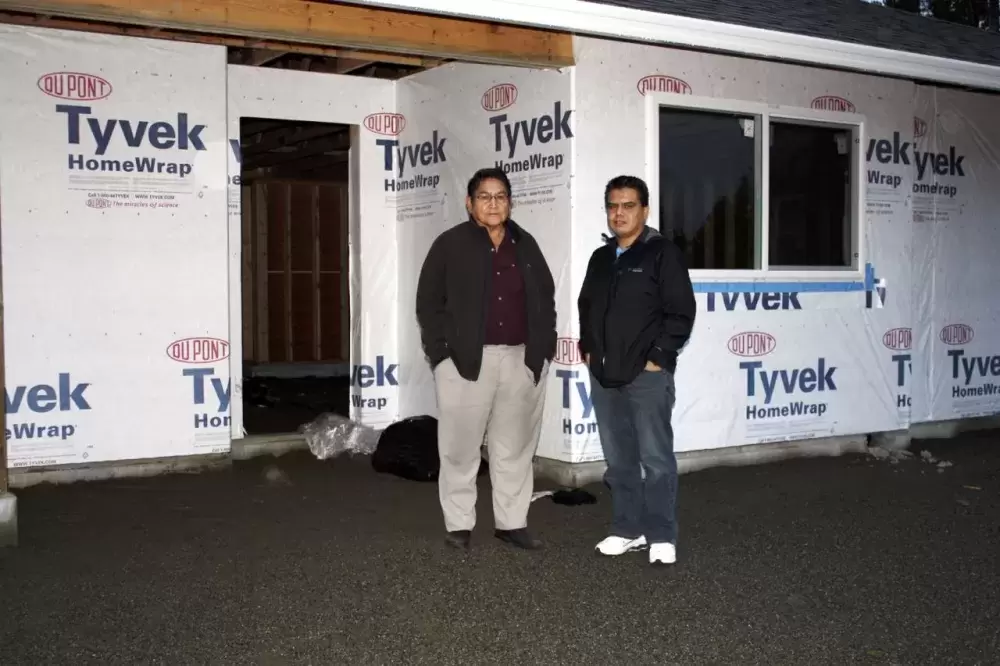The first houses are going up at Ty-histanis, and Tla-o-qui-aht leadership is inviting their members to drop by the new development and see for themselves how much has been accomplished.
Ty-histanis is an extension of Tla-o-qui-aht’s existing Esowista reserve located at Long Beach, near Tofino. Tla-o-qui-aht leadership fought long and hard with the federal government to win the extra 86.4 hectares that was once part of Pacific Rim National Park Reserve.
Tla-o-qui-aht’s two main reserves, Opitsaht, located across from Tofino on Meares Island, and Esowista, have long been filled to capacity. According to Chief Councilor Elmer Frank, there are more than 160 families wanting to move back home, but there was just no place to put them. Existing homes are already overcrowded; in some cases three or more families live in single family homes.
Phase I of the Esowista Expansion Project, with its 68 building lots, can go a long way to alleviate the overcrowding situation. Phase I is scheduled for completion in March.
Chief Frank invites his people from near and far to drop by and tour Ty-histanis.
“Don’t be afraid of the construction zone cones,” he advises. “Just come right in and have a look around.”
There are two well-marked entrances to Ty-histanis from the Tofino Highway and a connector road from Esowista. The roads are paved and street lights have been installed.
Visitors to the site can expect to see cleared housing lots, the large geo-thermal building and a courtyard-like area complete with sheltered mailboxes and parking stalls. Landscaping has begun using indigenous plants like cedar and ferns.
The new mail box kiosk will eliminate the need for Esowista residents to travel 10 km to the Tofino Post Office to pick up their mail.
Chief Frank says the band wants to encourage their people to select building lots and go through the necessary steps one must take to become a homeowner, and that is to secure a pre-approved mortgage.
“Chief and council are working with two banks to assist our people,” said Chief Frank. He encourages people to contact Tla-o-qui-aht Housing Coordinator Barb Masso for assistance or information about obtaining a mortgage.
“Once their mortgage is approved they can hire an architect if they like or select from six to eight home designs we have for them,” Frank explained. In a previous interview with Ha-Shilth-Sa, Chief Frank indicated there will likely be some rental housing available at Ty-histanis for Tla-o-qui-aht members.
For now, seven single family units are nearing lockup stage along with a nine-plex for a total of 16 new family housing spaces.
Near the center of the development is the geo-thermal building and field where pipes buried 300 feet into the earth extracts heat, warming homes economically through pipes embedded in the floors. The field is large enough to service 75 housing units but planners hope to use the space as a recreation area, making up to three ball fields which they hope to flank with a community center and a cultural center. Those plans are contingent upon securing the necessary funds.
“We want to make this the recreation hub with a large gathering place,” Frank explained.
TFN staff are also working on securing funds for a new health clinic and a volunteer fire department.
A nine-unit elders’ facility is near completion. Every rancher-style unit will be built to suit the needs of the mobility impaired.
Because there are not enough Tla-o-qui-aht elders needing housing to fill all nine units, planners are considering filling available spaces with young, single mothers. The idea, Frank explains, is to give inexperienced moms a place where they can be supported by other community members and social services staff, allowing them to learn the necessary life skills to raise happy, healthy children.
Tla-o-qui-aht members have been hired to work on the project and Discovery College has set up shop on site to train Tla-o-qui-aht members in the construction field. One of the homes nearing lock-up stage is built by the Discovery College students. It is expected to be complete by March.
Much of Ty-histanis was swampy prior to development. The area had to be drained and sediment ponds were created.
“For some reason, everything drains into this area; water never stops moving,” said Project Coordinator Moses Martin.
Tla-o-qui-aht hopes to find a use for the fresh running water and, perhaps, create employment opportunities for their people.
Martin pointed out that one very important thing is missing in all the good news about Ty-histanis, and that is the lack of employment opportunities in the region.
“We want the people to pay for it and take pride in what they own and (in order for them to do that) we need to find a way to provide the economic opportunities,” he said.
In addition to the new homes and community buildings, space has been set aside for a cemetery. A storage/utility area has also been set aside for large items like boats and vehicles.
“We want to build a model community and get away from having old boats and cars in people’s yards,” said Chief Frank.
In Phase II at least 50 more housing units will be constructed. Tla-o-qui-aht continues to negotiate with Indian and Northern Affairs for more funding to complete the development.
According to Moses Martin, the name Ty-is-tanis came from an elder who has since passed on.
“His interpretation was that it was a place to anchor whales,” Martin explained, adding, “more recently we anchored our fish boats at night to get out of weather during the fishing season. Now today we hope it will be a place to anchor our people that want to come home.”







